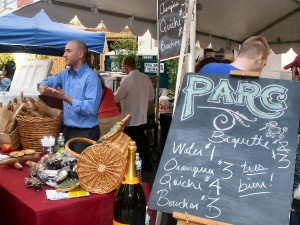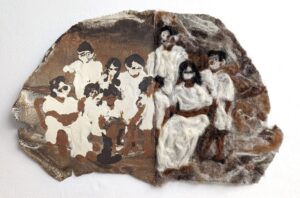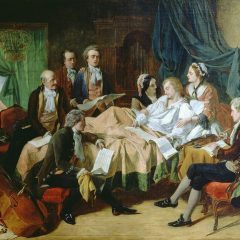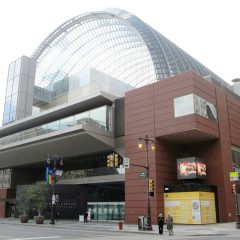The first time I heard of Paris, I didn’t know much about it except for the fact that it held “twelve little girls in two straight lines.” For me, Ludwig Bemelmans’ Madeline acted not as the introduction to a magical city, but as a traumatizing doorway into the world of hypochondria. (“You mean, my appendix can explode?!”) Parents unknowingly bestowed me that Christmas with a Madeline doll – complete with surgical scars on her stomach. Quite a few years (and somewhat less traumatizing Disney movies) later, Paris at last worked its way into my heart, its place as center of mystery and romance restored. This past Saturday, I finally experienced Paris first-hand in a reverse-Sabrina moment, where the city came to the girl.
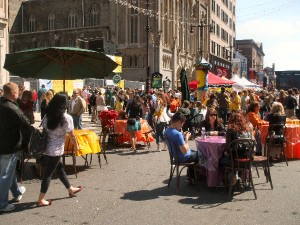
Emerging from the dank gloom of the Lombard Street subway station was like entering a Technicolor dream after a brief sojourn in Kansas. My eyes assaulted by lights and colors almost too bright for the 3D world, I found myself lost in a Carnivale that had sprung up overnight in the middle of Broad Street. Tents and umbrellas popped up like mushrooms, street performers weaved through the crowds, and music flitted like living creatures from all directions at once. From 11 am to 8:30 pm on April 30, young and old, locals and tourists alike, wandered through six blocks of homegrown Paris at the Philadelphia International Festival of the Arts Street Fair.
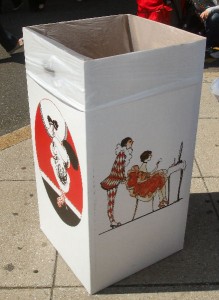
“I think it’s tremendously exciting to see Broad Street so transformed, to see so many people out, people of all different kinds,” remarked local Ariel Weiss, as she sprawled on a garden populated by hedge animals and lounging festival-goers.
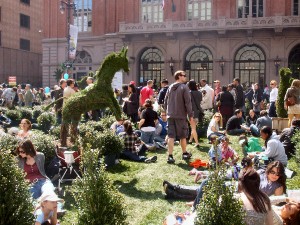
According to Ed Cambron, Executive Director of PIFA, the most important goals were “celebrating the arts culture of Philadelphia” and “exciting people” about the range of performances and venues open to the community. Inspired by 1911 Paris as a center of artistic innovation, the Avenue of the Arts and the Kimmel Center lobby underwent an international metamorphosis.
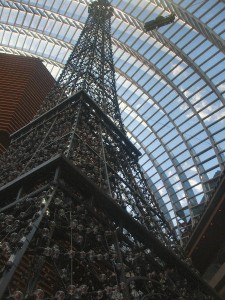
Set designer Mimi Lien used the inspiration of the Kimmel Center’s floorspace, airspace, and vaulted glass roof to come up with her designs for the Eiffel Tower replica, and for a series of trains, plains, and zeppelins that criss-crossed the Kimmel ceiling on wire lines. The technological framework of 1911 Paris led to the choice to utilize light bulbs and flying machines in her work.
“I decided to make the lobby into a space reminiscent of a train station, in response to the glass roof of the Kimmel Center, which resembles so many great train stations in Europe of the Industrial Age – a place of intersections and connections,” Lien said. “My hope is that visitors come away having experienced the building in a different way, having felt the volume of space more palpably, and also to have felt (even subconsciously) the bridging of time from the present to 100 years ago.”
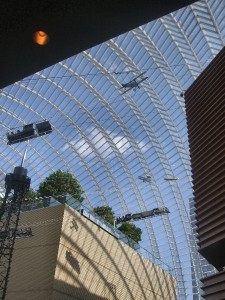
While the main attractions of the fair included two stages of musical entertainment–a giant crane in the middle of Broad Street for a La Compagnie Transe Express performance later that night, and a Ferris Wheel–it was the small details that brought the fair to life. Fresh flowers and herbs hawked by vendors on the street, along with the smell of baguettes and sliders, called to mind an open air market tucked away in a cozy European alley. Meanwhile, a line for crepes in the Kimmel Center stretched to amusement park proportions, as others sampled wine beneath the Eiffel Tower replica. Even crowd members joined in the fun: a little girl dressed for the occasion in a Belle gown, while self-made mimes peered with painted faces over Kimmel Center balconies.
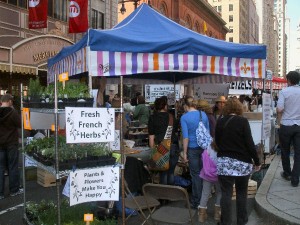
Sometimes, living in a city can make you forget that the great outdoors offers so much more than occasional summertime trips to the seashore. Once upon a Saturday, for the brief space of nine-and-a-half hours, the PIFA Street Fair reminded us that, every now and then, all you need are a few friendly smiles and a picnic lunch.
